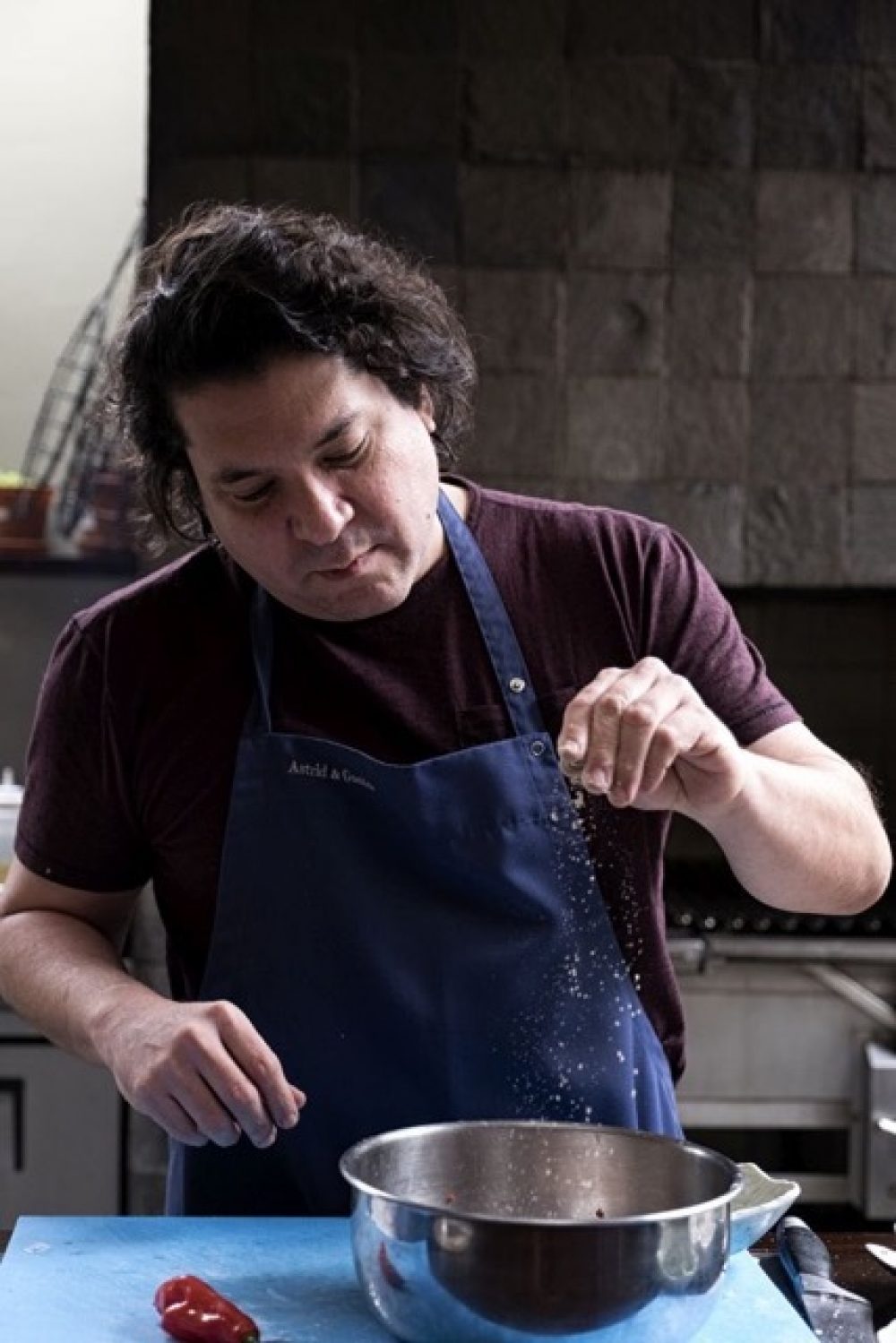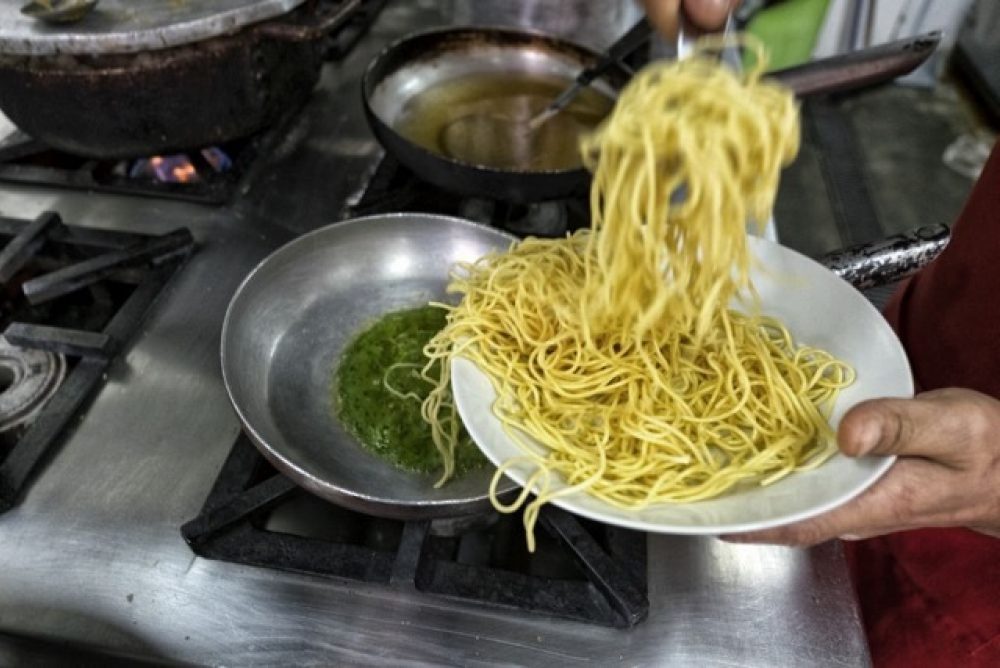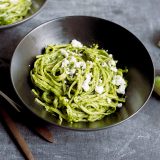Waves of Italians poured into Peru, a country situated at the crossroads of ocean, desert and mountain. It was the mid-1800s and it must have been jarring.
At the time, this was a country where the starch was not pasta, but potato—in more than 2,000 varieties. Where basil and Parmesan were mostly unknown. Where the Italians were outsiders seeking better fortunes.
Many came from Genoa, a port city in northern Italy that is the spiritual home of the robustly garlicky pesto Genovese Americans know best. And when the Italians sought comfort, they looked back across the Atlantic.
As they acclimated, their foods became a mediation of cultures, explains Gaston Acurio, Peruvian mega-chef and unabashed ambassador for his country’s cuisines.
It is how minestrone became “menestron,” a classic Peruvian festival food, albeit with yucca, corn and beef. It is how ragu Bolognese became a sauce of slow-cooked chicken.
And it is how pesto became “tallarines verde,” a fresher, creamier and distinctly Peruvian iteration of its Italian ancestor. Gone were the basil, Parmesan and pine nuts, replaced with the lighter flavors of spinach, cream and queso fresco. It was this dish and its cleaner, simpler flavors that brought me to Lima.
“It became a kind of dialogue or maybe a love story” between two worlds, Acurio says as we eat deliciously briny, piquant razor clam and sea urchin ceviche at La Mar, his airy restaurant where the walls don’t quite meet the ceiling. Breeze and bustle drift in. It rains so infrequently in Lima—a city that hugs the Pacific but is surrounded by desert—the gaps are no bother.
For more than two decades, Acurio has pushed the world to take notice of Peru’s vibrant cuisines, and to transform Lima into a culinary capital. In the process, he created a global empire of dozens of restaurants and opened a culinary school for children from impoverished areas.
It has made him something of a hero here; fans regularly beg him to run for president. He’s so far declined, saying he’d rather focus on real food for real people. Food such as tallarines verde.
“Rich or poor, you have tallarines verde at your house,” Acurio said. “If you’re rich, maybe you have it with tenderloin. If you don’t have much money, maybe you have tallarines with fish on top. But it’s very, very traditional home Peruvian cooking. Everywhere.”
But tallarines verde is to pesto as Chicago deep-dish is to the Neapolitan original: They owe their heritage to the homeland but have evolved into dishes entirely their own.
The transformation was natural. Even essential. When Italians first came to Peru—an almost breathtakingly culturally diverse country adept at incorporating the cuisines of others—basil and olive oil were rare commodities. Same for Parmesan, pine nuts and pasta.

Gaston Acurio
“It became a kind of ... love story,” says Gaston Acurio of tallarines verde, one of many culinary connections between Italy and Peru.
The pasta, they could make. And so spaghetti entered the Peruvian culinary lexicon. The rest were harder to come by. So Italians adapted to what was on hand, unwittingly creating a deliciously distinct dish.
That is how sweet spinach, of which Peru had an abundance, replaced peppery basil. How cream or milk took the place of the oil. How pine nuts disappeared, sometimes replaced by walnuts or pecans but mostly ignored. How mild queso fresco stood in for salty, umami-rich Parmesan.
In time, Acurio explained, tallarines verde was no longer ItalianPeruvian food. It was simply Peruvian—not assuaging homesick Italians, but comforting all Peruvians. It gained potatoes, served with cream sauce on the side. Because this is Peru, and everything is served with potatoes. It was topped with a thinly pounded, vibrantly seasoned, deeply fried steak.
Over several days I ate many plates of tallarines verde, watching chefs make restaurant crowd-pleasers, grandmothers’ secret recipes and numerous variations between. They all tasted far from Genoa. Pesto Genovese is peppery, richly savory, even pleasantly gritty. Tallarines verde is creamier, with a lighter flavor that tastes more of fresh greens than herbs.
Also, Peruvian pesto is cooked, simmered in the pan before the pasta is added. The result is a sauce mellower than raw Italian-style pesto. Acurio guesses this may actually be a nod to a classic Italian technique. Though less common now, basil once was regularly blanched before going into pesto, a move that preserves the herb’s bright green color and tames its bite.
Back at Milk Street, we started with the sauce. Because it is cooked and reduced, we needed nearly a pound of fresh baby spinach, and we needed to puree it in batches. A bit of onion and garlic rounded out the flavor and added a welcome savoriness once cooked.
Cooking pesto seemed counterintuitive, but it simmered easily in a large skillet and in minutes had a wonderfully rich taste and smooth texture, particularly once thickened with some pasta cooking water.
In Peru, the pasta is partially boiled, then drained and added to the sauce, where it finishes cooking in the skillet. We loved this technique, which effectively under-hydrates the pasta and allows it to absorb—rather than simply be coated by—the flavorful pesto.

We found that undercooking the pasta by about 2 minutes, then finishing it in the skillet gave us perfectly cooked, deeply flavorful pasta.
We found that undercooking the pasta by about 2 minutes, then finishing it in the skillet gave us perfectly cooked, deeply flavorful pasta.
As Parmesan has become more available in Peru, it has worked its way back into tallarines verde as a final sprinkle. We liked the savory, salty notes this added, so we stirred in just a bit before finishing the dish with the traditional queso fresco and a squirt of lime juice.
Though in Peru it is traditional to accompany the dish with potatoes and top it with fried steak or fish, we found these overkill. We loved the simple, fresh flavors on their own. Consider it an American variation on the Peruvian variation of this Italian immigrant.




